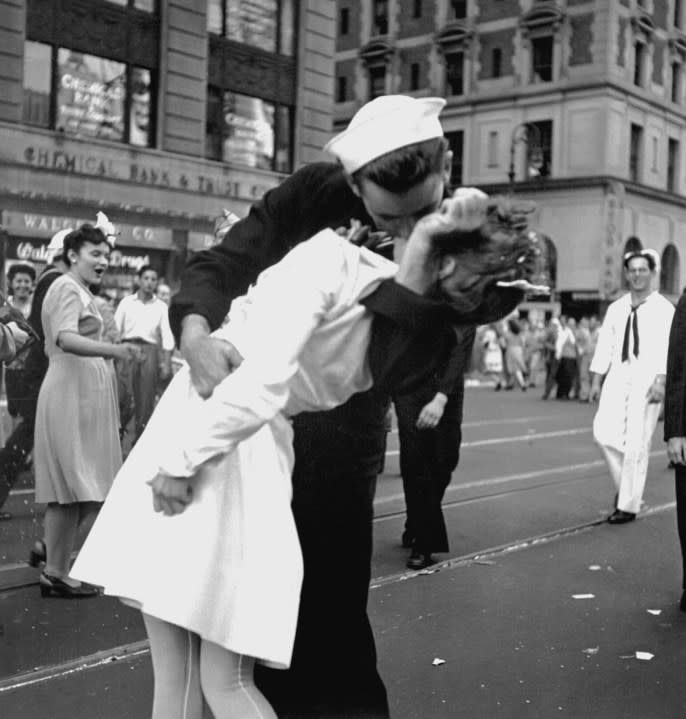How San Diego’s ‘kissing statue’ became a fixture on the downtown waterfront

SAN DIEGO – Whether you’re from here or just visiting, San Diego’s eye-catching statue replicating the iconic World War II-era photograph of a lip-locked sailor and a nurse is something everyone knows.
The 25-foot installation – known as “Embracing Peace” – is one of the most recognizable ornaments of the San Diego bayfront, placed right next to the USS Midway. Hundreds of people visit the spot every day — many stopping by just to snap a picture recreating in the pose.
“There is (likely) no more photographed spot,” said Allan Tait, program manager for the Parks and Recreation Department. “It’s iconic, because it’s (this) colossal sculpture … It’s become recognizable with San Diego.”
With its nearly two decade-long presence at the Embarcadero, many locals at one point or another might have wondered how the sculpture depicting a famous moment that took place in New York City become an enduring emblem of America’s Finest City.
How artists transformed the Spanish Village in Balboa Park
The artwork was first brought to San Diego’s Tuna Harbor Park in 2007 on a 15-month loan from the Sculpture Foundation in Santa Monica.
Then called “Unconditional Surrender,” it was created by artist Seward Johnson two years prior as a temporary display meant for Times Square, commemorating the 60th anniversary of the day that marked the end of the war on the Pacific Front, “Victory Over Japan Day.”
Johnson crafted the statue from bronze to resemble a seminal 1945 photograph that captured the spontaneous moment of a sailor and a nurse kissing while out celebrating at day.
Most people assume this inspiration was Alfred Eisenstaedt’s famed “V-J Day in Times Square,” but the artist actually cited his source as a lesser-known, public domain photograph by Navy Lt. Victor Jorgensen that captured the same moment.
Multiple versions of the statue – including models out of styrofoam and aluminum – were also created for a nationwide tour that started in Sarasota, FL.
San Diego ended up being one of the sites where a foam-urethane model was put on display and the port added it to Tuna Harbor Park’s “Greatest Generation Walk,” honoring the city’s naval history with multiple WWII memorials.
“The idea of taking out sculpture on loan fit into (the) strategy at the time to get people out to the waterfront,” Tait explained. “The artwork became extremely popular … people were astonished with it.”
However, its display stirred up some controversy both amongst the Port of San Diego, its public art committee and members of the public for its “kitsch.” In 2007, one San Diego Union-Tribune art critic described it as a “monumental-scale caricature of Eisenstaedt’s photograph.”
“It turned out to be quite an attraction,” said Karl Zingheim, historian with the USS Midway. “It had both positive and negative reviews of course, like any piece of public art would, but it did turn out to be quite a draw for the public.”
For that very reason, the Port of San Diego continually applied for extensions to its loan until 2012, when it was dismantled and removed from the site. The city then began eyeing ways to bring it back as a permanent bronze sculpture.
After a contentious 4-2 vote of the port district board approving the replacement, commissioners directed supporters of the statue to raise the necessary funds for its installation.
The USS Midway alongside local architect Donald Reeves led the campaign to raise funds for the effort, raising $1 million in eight weeks.
“San Diego was a natural choice to be able to have it on public display,” Zingheim said. “Not only because of the contributions that the San Diego community made to World War II, but its ongoing contributions to this very day as a primary naval base.”
“It just so happens that (the statue) became so popular in this particular area as a public curiosity and attraction that the museum saw fit to help contribute to a drive to have a permanent replica statue put in instead,” he added.
9/11 ceremonies being held around San Diego County
The roughly 7-ton bronze replica was officially installed in 2013, after being transported from New Jersey via a flatbed truck. To this day, it remains a favorite photo op for visitors of all ages – from teenagers to grandparents.
“Just like with the Eiffel Tower in relation to Paris, eventually it’s become accepted as a part of the landscape and is a feature that people can’t remember a time when it wasn’t there,” Zingheim said.
While for many the statue is just part of the background that makes up the downtown waterfront, the “Embracing Peace” statue serves as a tribute to the generation that lived through the World War, symbolizing the widespread joy after the fact and the prospect of a better future.
“As a destination, it has a lot of sentimental value,” Tait added. “It’s a living memory of the second World War.”
For the latest news, weather, sports, and streaming video, head to FOX 5 San Diego.


